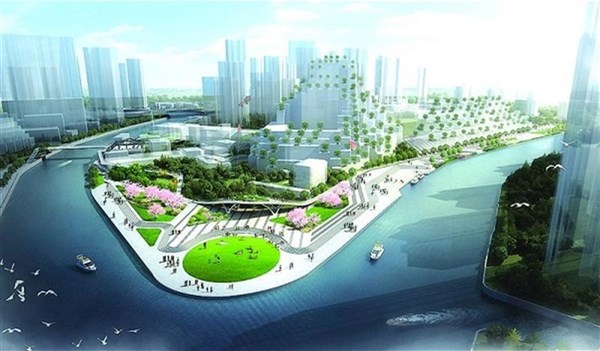Shanghai Today
Riverside attractions developed for downtown Suzhou Creek - December 07, 2018
苏州河畔规划“苏河八景”

The downtown section of Suzhou Creek was once home to China's earliest industries such as textiles, flour and paint factories.
Urban planners now aim to convert those industrial relics into exhibition centers, theatres and other recreation venues, while developing attractions along the creek, including the M50 Art Hub on Moganshan Road, one of the first and most notable cases of industrial heritage being converted for cultural purposes.
Along the creek, the former Union Brewery at 130 Yichang Road is now a popular garden complex and events venue. Over 100 galleries and studios are in operation, making it not only a thriving community, but also a popular attraction for local and international visitors alike.
Beside the creative park, the “1,000 Trees” project is nearing completion to become another attraction. Weddings and outdoor concerts will be held in front of the commercial and hotel complex.
The initial phase of the project will open to public late next year and include restaurants, museums, art galleries and entertainment sites. There will be up to 1,000 balconies filled with plants and trees.
Four buildings which comprised China’s earliest private flour factory which opened in 1900, have been preserved as a museum, art gallery and restaurant.
The Fufeng Flour Factory, which became the Shanghai Flour Factory in the 1960s, was owned by brothers Rong Zongjing and Rong Desheng — China’s “kings" of flour and textiles.
Another riverside attractions is an electronic sports center at the Caojiadu area, which is famous for once the city's largest downtown flower market, which has been closed and will be demolished for the e-sports blueprint.
The site will serve as the home courts of China’s top e-sports clubs — EDward Gaming and TOPSports — upon its completion around 2021. Construction on the e-sports center will start in early 2019.
The neighboring Huxi Cinema, established in 1926, is also undergoing a redevelopment that will see it emerge as a new theater and studio for the music and creative industries.
The 125km Suzhou Creek, which flows from Qingpu District to the Waibaidu Bridge, is the biggest tributary of the Huangpu River. The waterfront is being developed into a multifunctional and dynamic zone to reflect humanities, culture and ecological environment.
About 42 kilometers of the Suzhou Creek waterfront in Shanghai will be converted into walkways as city planners work to make more room for pedestrians. The whole project — 21km each on both sides of the creek — is expected to be completed by 2020.
Half of the sections which feature most of the industrial heritages is in Putuo District. The planners have designed 10 new bridges for section to better connect the attractions on both sides of the creek.
The average distance between bridges will be reduced to 100 meters on the section near the Bund, 120 meters for other downtown sections and 200 meters for the area within the outer ring road, according to the Shanghai Urban Planning and Natural Resources Administration, the city's urban planning body.
The riverside walkways along the Putuo section are currently interrupted by 19 structures, either belonging to companies or residential communities. The planning authority will remove these breakpoints to allow residents to walk along the creek freely.
Application Status
| 04-16 | 21315227 | Processing |
| 03-12 | 21315226 | Processing |
| 09-26 | 21315225 | Processing |
Inquiry Status
| 02-29 | 02131558 | Received |
| 03-06 | 02131557 | Received |
| 11-14 | 02131556 | Received |
FAQ
Q: Q: Is there a place where I can get...
A: A: Log on to http://touch.shio.gov....
A: A: Log on to http://touch.shio.gov....
Q: Q: What is the easiest way to set u...
A: A: 1. Log on to http://touch.shio.g...
A: A: 1. Log on to http://touch.shio.g...
Q: Where can I get an English map of S...
A: English maps of Shanghai are availa...
A: English maps of Shanghai are availa...

